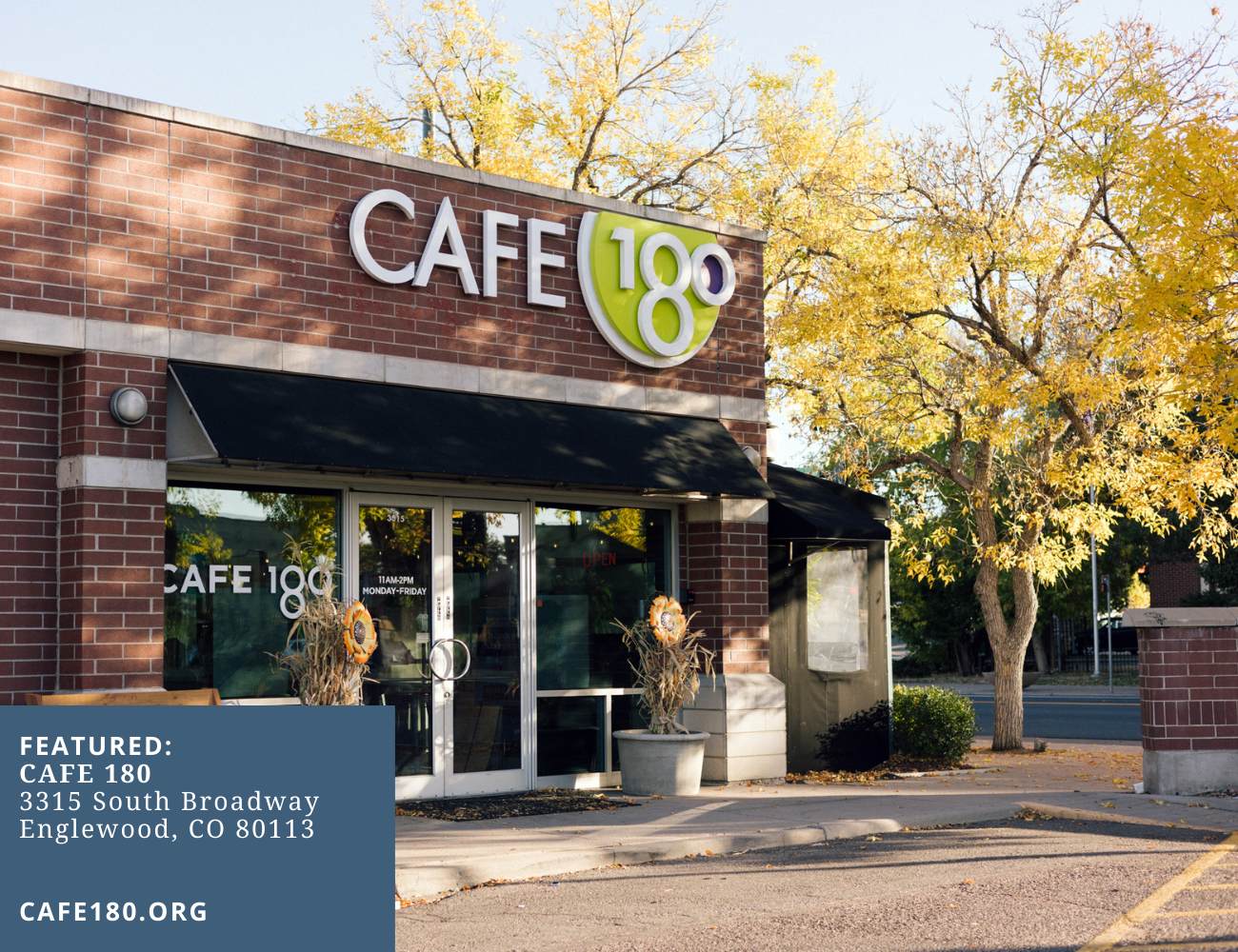RHYTHMS | PRAYER, PRACTICE, PLACE
Vol 3. Issue 20
Friends,
From local farms to those experiencing food insecurity, the focus of this issue is food.
It includes a Prayer for the Dirt by Michelle Stinson, the Practice of Farm Shares by Margo Wanberg, co-founder of City Park Farmers Market and Lafayette Farmers Market, and CAFE 180, who is celebrating 15 years of providing a space for everyone to feel good about the food they eat, as a sacred Place.
One of the gifts of curating content is sharing brilliant writers and inspiring organizations like those featured in this issue. Our hope is their words encourage your life and faith to be more deeply rooted in place.
All blessings.
Jared Mackey
P.S. – Make your reservation to attend Art & Place on Thursday, October 9, for the gallery opening and local artist panels on the integration of geography and creativity.
PRAYER | DIRT: A HYMN OF PRAISE
By Michelle Stinson
Glory be to God for Dirt—
For backyard soil
as dark and dense
as the midnight sky.
And for all the creatures
who make this ground
their earthy home—
the wiggly ones
and leggy ones
and the tiny ones
our eyes can’t see.
For muddy puddles
on neighborhood paths,
beckoning little feet
to jump and splash,
and little hands
to squish and form
hand-packed mud pies
(nature’s finest!)
for a friend.
For that Garden ground
first lovingly made,
now put to new use
when scooped up
in the Creator’s hands.
Dusty-earth made alive
with divine-breath.
Humus-formed humans,
crafted and blessed.
For dust you are
and to dust you will return.
And so, in the meantime . . .
May we learn to see and love
those creatures, small and great,
who inhabit our neighborhoods
as their earthy abodes.
May we be quick to share,
with neighbors (known or new)
our garden plenty
or just store-bought greens,
being ever astounded
by the gifts of sun and soil.
And on this dust-to-dust journey,
may our hubris
give way to humility,
remembering always
with gratitude and awe,
our humble beginnings
in this simple gift of dirt.
Amen.
Michelle Stinson finds herself delighting in this present season of writing, speaking, and getting her hands in the dirt. She regularly speaks and writes on food, hospitality, land care, and the Psalms. She is a trained Spiritual Director and a Visiting Scholar in Old Testament at Denver Seminary.
PRACTICE | CSA
By Margo Wanberg
“When you join a CSA, you agree to share in both the risks and the rewards of farming.”
Practice
Join a CSA. Find a local CSA or farm share and try it for a season.
Choose relationship. Learn your farmer’s and host’s names; introduce yourself in person at pickup.
Share the bounty. Share your vegetables with neighbors, or use the produce to cook a meal for a neighbor.
Adopt a slower pace. Plan time to allow for the CSA pick-up and cooking at an unhurried pace.
My family and I joined Monroe Organic Farms’ CSA this past year. Each week, Monroe would drop off a handful of shares at a neighbor’s home and everyone would come by to pick up their share. Along with getting big bags of beautiful produce each week, I got to know the Monroe family more deeply, along with Mary Ann, my neighbor who sat in her garage for two hours every week distributing the shares.
CSA stands for Community Supported Agriculture. It’s a mutually beneficial partnership between farmers and consumers. By purchasing a share of the harvest in advance, members support the farm upfront and in return, receive regular portions of fresh, seasonal produce throughout the season.
When you join a CSA, you agree to share in both the risks and the rewards of farming. A challenging season may bring smaller yields, while a flourishing year overflows with abundance. At its core, a CSA is about joining the journey with a local farm. Advanced payment gives farmers the stability they need to plan, plant, and nurture the season ahead of time. It’s a way of saying, we value your work, while choosing local, nutrient-dense food and the farmers who grow it (rather than lettuce shipped from 2,000 miles away).
A CSA is also a beautiful way to connect more deeply with the individuals who grow your food, the seasons we all live within, and the land that we live on. As farmers ride the whims of the growing season, we get to ride alongside them… choosing people in our community and the shared purpose of supporting local food that carries far more meaning than a grocery run. When we eat carrots harvested by someone whose name and story we know, those carrots take on greater purpose. Sitting down to a meal made from the hands of farmers we’re in relationship with transforms the table itself and the food becomes more than fuel - it becomes connection, gratitude, and community shared with everyone partaking.
Then there’s the lovely mystery of the vegetables that show up in my CSA box each week! Sure, I can only eat so many potatoes and squash at a time, but the abundance pushes me to get creative. And sometimes, creativity looks like giving. When there’s more than my family can eat, I love cooking up the extra produce and blessing neighbors with warm meals from our kitchen. In an odd way, both giving and receiving a meal feels vulnerable. Cooking for someone else means exposing your food, your style, your skill (or lack thereof). Receiving a meal means opening yourself to eat something you didn’t plan, shop for, or prepare yourself. And yet, that exchange is where the beauty lies… food as a bridge that is both humbling and connecting us in ways nothing else quite can.
Over the time frame of the CSA, the pickup host, Mary Ann, ended up learning my kids’ names and asking about them, providing advice about my job, and getting updates on the many house projects I had going on. I learned about her grown children, her travels, and her passion for CSAs. Picking up food from her home each week wasn’t just about the produce, it was about fostering a new relationship with a neighbor while receiving stunning, seasonal food from farmers I was learning to deeply love. It was about learning from others how to slow down and sit in the driveway, listening to strangers and grounding ourselves in present company and locally grown food. Buying into a food ecosystem is driving a connection to the person, the seasons, and the land. It’s a beautiful rejection of the fast paced food world we’ve come to accept and we’ve become addicted to. And it's surrendering to the good design of nature’s pace.
Margo Wanberg is the co-founder of the City Park Farmers Market and the newly launched Lafayette Farmers Market. Born and raised in Denver and a CU Boulder alumna, she is passionate about sustainable living, beekeeping, and being rooted in community. She finds joy in connecting people with their local food systems and supporting small-scale farmers and producers. Margo and her husband, Peter, reside in Lafayette, where they enjoy raising their three children.
PLACE | CAFE 180
By Jared Mackey
“We believe everyone deserves good food.”
CAFE 180 is a sacred place. For fifteen years, this light‑filled corner cafe in Englewood has welcomed neighbors to share good food with gracious hospitality. The promise of the cafe is profound: the way a meal is served with dignity cultivates belonging. “We’ve been really careful to never change the way we serve people or the way we present food depending on how much someone’s paying for it,” says Sarah Lesyinski, Executive Director of One Good Turn, the parent organization of CAFE 180.
Founded in 2010, CAFE 180 was born from a vision that neighbors flourish when they eat together and work together. Over the last decade and a half of serving food in Englewood, the business model has adapted with the changing needs of the neighborhood. But their core mission remains true: food, dignity, and community. Over 15 years, CAFE 180 has served over 150,000 meals to people experiencing food insecurity, with 100,000+ volunteer hours, and more than 1.5 tons of garden produce that has been donated and used in meals.
CAFE 180 remains a constant presence in a neighborhood of shifting cultural and economic changes. It is open weekdays for breakfast and lunch and provides catering across the Denver metro area. All proceeds go to support preparing meals for neighbors experiencing food insecurity. “We are serving anywhere from six to seven hundred meals per week,” Sarah notes, which is a reminder of the need and the tangible way the cafe loves their neighbors. When you walk inside CAFE 180, you find a lunch‑forward menu—sandwiches, soups, salads, pizzas—made with care and priced for families to be able to go out to eat. It is an attractive restaurant that refuses pretense. A place where regulars are known by name, and newcomers are inspired by how their $10 lunch can be a small part of meeting the bigger needs of the community.
The stories of CAFE 180 are as nourishing as the food. Sarah smiles sharing David’s story. David first came in to work for a meal while experiencing homelessness. He volunteered around the cafe for six months, then one morning, when volunteering, he fixed a problem with the electricity in the cafe—drawing on his 35 years as an electrician. His gifts that had been hidden by hard seasons were welcomed back. “Watching people use their gifts and talents in a way that they don't typically get to, happens all the time here at the cafe. It is so special, because people have a lot of gifts and talents, and you can't always see that when you first see them,” says Sarah.
Being rooted in place has led to being rooted in community responsibility. As housing costs rise and the neighborhood changes, CAFE 180 expanded its care—partnering with the city and schools, hosting community dinners, and educating neighbors about the often‑hidden reality of food insecurity. Sarah shares the truths about operating an organization at the intersection of community and food insecurity. “Food always brings people together. Sometimes that's easy, and sometimes that's really challenging. It feels over our 15 years the cafe has held both stories.” Her passion for the people and place is palpable: “My hope is that the cafe feels steady, a place of belonging, a place where people feel known.”
CAFE 180 is a living parable. It is a place of shared meals and shared lives. Its living legacy is a place of nourishment and belonging. A corner cafe where neighbors are known, their stories are heard, and the dignity of every person who walks through their doors is held. CAFE 180 is a sacred place.
Thank you to Sarah Lesyinski for her compassion for the deep needs of belonging and nourishment in our city, and her joyful conversation and contribution to this article.
PARTICIPATE | ART & PLACE
Enter a place where visual creativity and attention to geography meet.
Art & Place explores how visual art connects us deeper to place.
On Thursday, October 9, attend the opening gallery at Anthology Fine Art to celebrate local artists whose work is shaped by place.
There will be artist panels exploring the often unseen influence of place on art, and asking how art can inspire us to love the people and places around us.
Signature cocktail, wine, and hors d'oeuvres will be served.
Reserve your space to spend an evening celebrating the beauty of art and place.
More rhythms to root your faith in place.
Sacred Place provides a beautiful bi-weekly publication to share the rhythms of a Prayer, Practice, and Place as simple ways to help cultivate love for our neighbors and neighborhoods.









